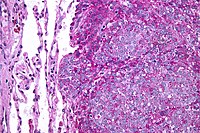Skeletal Ewing Sarcoma

Ewing's sarcoma is a malignant small round cell bone tumor with strong metastatic potential.
Epidemiology
Annual incidence is estimated at 1/312,500 in children under the age of 15.
Clinical description
It occurs between the ages of 5 and 30 with a peak of incidence between ages 12 and 18. The most frequent symptom is pain. Other symptoms depend on the organs closest to the tumor: motor, sphincteric disorders caused by nervous compression or mechanical disorders are associated with pelvic tumors; respiratory disorders or pleural effusion are associated with costal tumors; medullar or radicular compression are associated with vertebral tumors. The tumor initially develops most frequently in bone, particularly in the pelvis (30%), thorax (rib, clavicle, scapula) (20%), femur (16%), tibia (9%), vertebrae (8%) and humerus (5%). The disease has a high potential for metastases (lung, bone, bone marrow). Neuroepithelioma is a highly differentiated neural variant (see this term). Askin's tumor is a thoracic variant which can be slightly or well differentiated.
Etiology
Although no specific cause has been identified, a specific translocation involving the EWSR1 gene (22q12.2) is present in 90% of tumors of this type, most often a translocation t(11;22)(q24;q29). Many variants of this translocation have been described (involving the ERG, ETV1, FLI1 and NR4A3 genes).
Diagnostic methods
The diagnosis is suggested after the identification, by PCR (polymerase chain reaction), of these translocations.
Differential diagnosis
Differential diagnoses include other small round cell tumors: neuroblastoma, embryonal or alveolar rhabdomyosarcoma, non-Hodgkin's lymphoma and mesenchymatous chondrosarcomas (see these terms). The existence of a translocation involving the EWSR1 gene allows these diseases to be ruled out.
Management and treatment
Treatment should be managed by a multidisciplinary team with expertise in treating childhood cancers. Treatment starts systematically with chemotherapy to reduce the size of the primary tumor and to eradicate or prevent metastases. Surgery is recommended whenever the location of the tumor allows. Local radiotherapy is sometimes necessary, either in addition to surgery or alone for inoperable tumors. For more severe forms of the disease (limited response to initial chemotherapy or metastases already present at diagnosis), high dose chemotherapy with stem cell transplantation can be suggested as a last resort treatment. Targeted therapies, for example with anti-IGF-R (insulin-like growth factor receptor), are currently being studied.
Prognosis
Survival without recurrence of localized forms is around 70%. For forms with lung metastases the survival rate is around 50%. Forms with metastases of the bones or bone marrow have a more severe prognosis.